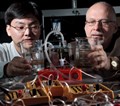Researchers Develop Energy-Saving Breakthrough For Desalination

When environmental engineer David Drew read about an amazing new method of removing salt from seawater, he embarked on a search for research institutions to collaborate with on this kind of technology.
He didn't have to go very far to find one.
Zhen "Jason" He, an assistant professor of engineering at the University of Wisconsin–Milwaukee (UWM), was working on just such a project only a few miles from the Cedarburg office of Gannett Fleming Inc., the international engineering consulting firm Drew works for.
He is improving a microbial fuel cell that generates electricity using wastewater, while also purifying the water. But after talking with Drew, He modified it, adding a third capability: desalinating a separate supply of water.
Zhen "Jason" He, assistant professor of civil engineering (left), and David Drew, a project manager with Gannett Fleming Inc., show the input and output of a prototype microbial desalination cell. It's important to a company like Gannett Fleming, which designs and builds water and wastewater treatment plants. And the cost of energy, says Drew, is the reason desalination is so expensive.
In fact, says He, the energy from their microbial desalination cell (MDC) can drive its own desalination process. "It won't do the job entirely, but it can act as an energy-saving pretreatment for saltwater," says He. "That would greatly improve efficiency while holding down costs."
The two organizations are now working jointly to develop an MDC and bring it to market.
It is the second formal research collaboration between a water-related business and a UWM faculty member since the creation of UWM's graduate-level School of Freshwater Sciences just under a year ago. And He is pursuing patent protection of his ideas through the UWM Research Foundation.
Scaling up "Wastewater contains energy waiting to be harnessed," says Drew. "So the water and the energy are both addressed with this research." He chose the UWM scientist's lab over several others in the country because of its progress in making the technology more viable for commercial use.
He's lab members are increasing the size and scope of the prototype they began with, which was small enough to fit in the palm of the hand and could only process 60 milliliters of wastewater at a time.
"Dr. He's lab was the only one that had a good solution for scaling up the operation," says Drew, "so that it gives you the necessary energy recovery while also the sustainability of recycling the wastewater. We did a fair amount of due diligence to determine where best to put our investment."
The reactor itself is a three-chambered device in which microbes feed on the organics in the wastewater of one chamber, causing removal of ions from saltwater in an adjacent chamber. The metabolic energy created by the microbes also is the catalyst that produces the current.
Building a business The next step, and Phase I of the partnership, will be to produce an even larger reactor. If the first year goes well, the partners have the option of continuing with a Phase II, in which they will test the reactor's commercial viability.
"We want to put it on the fast track," says He. "We don't want it to stay in the lab for another five years."
But an equal priority, adds Drew, is that the partners align the research with the business plan behind it, so that "the two parts are not operating in isolation."
In designing a business plan, they started with a wide spectrum of possible applications for the work and winnowed it down to identify the specific market niche they wanted to target. "That helped us focus very quickly," says Drew, who has both a bachelor's and master's degree in applied math and physics, and engineering, from UWM.
It's not just the financial support that's important to his lab, says Professor He. "Being an academic, I know very little about industry standards. This way, we can benefit each other."
SOURCE: The University of Wisconsin–Milwaukee
